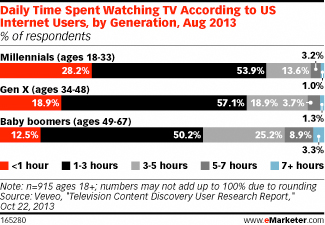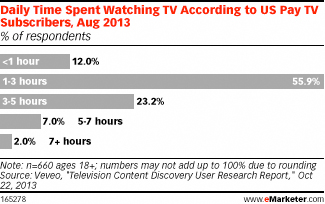Most Pay TV Subscribers Still Watch for Hours
November 7, 2013
![]() There’s been much hand-wringing of late over the idea that television watchers are cutting the cord—ending their cable TV subscriptions in favor of a range of video-on-demand (VOD) systems that deliver content via the internet. While news of the death of cable television might be premature—at least for the time being—research shows that pay TV services may be doing itself harm by failing to keep up with elements of usability that consumers have come to expect online, such as the ability to search for content.
There’s been much hand-wringing of late over the idea that television watchers are cutting the cord—ending their cable TV subscriptions in favor of a range of video-on-demand (VOD) systems that deliver content via the internet. While news of the death of cable television might be premature—at least for the time being—research shows that pay TV services may be doing itself harm by failing to keep up with elements of usability that consumers have come to expect online, such as the ability to search for content.
 Much of the consternation over cord-cutting has focused on millennials; these digital natives are generally expected to be more likely to forgo cable television in favor of online content. An August 2013 survey from Veveo found that millennials more often watched television for shorter periods of time than either Gen Xers or baby boomers. But almost 54% of millennials said they watched between 1 and 3 hours of television daily. Meanwhile, larger numbers of baby boomers watched at least 3 hours of TV every day than both millennials and Gen Xers.
Much of the consternation over cord-cutting has focused on millennials; these digital natives are generally expected to be more likely to forgo cable television in favor of online content. An August 2013 survey from Veveo found that millennials more often watched television for shorter periods of time than either Gen Xers or baby boomers. But almost 54% of millennials said they watched between 1 and 3 hours of television daily. Meanwhile, larger numbers of baby boomers watched at least 3 hours of TV every day than both millennials and Gen Xers.
 Overall, the majority of pay TV subscribers—almost 56%—watched between 1 and 3 hours of television daily. A little more than 23% watched between 3 and 5 hours, while 12% watched for less than 1 hour. Only a very dedicated few, about 9%, indicated that they watched more than 5 hours of TV per day.
Overall, the majority of pay TV subscribers—almost 56%—watched between 1 and 3 hours of television daily. A little more than 23% watched between 3 and 5 hours, while 12% watched for less than 1 hour. Only a very dedicated few, about 9%, indicated that they watched more than 5 hours of TV per day.
Unsurprisingly, the survey revealed that pay TV subscribers owned high-end TVs in relatively large numbers. High-definition TVs had a penetration rate of 73% among respondents. Game consoles were the next most popular device, at 55%, followed by iPhones (52%), iPads (40%), ereaders (36%), other smartphones (35%), and web-enabled TVs (34%). Pay TV subscribers were less likely to own portable gaming devices or streaming media devices, such as a Roku.
Courtesy of eMarketer




























